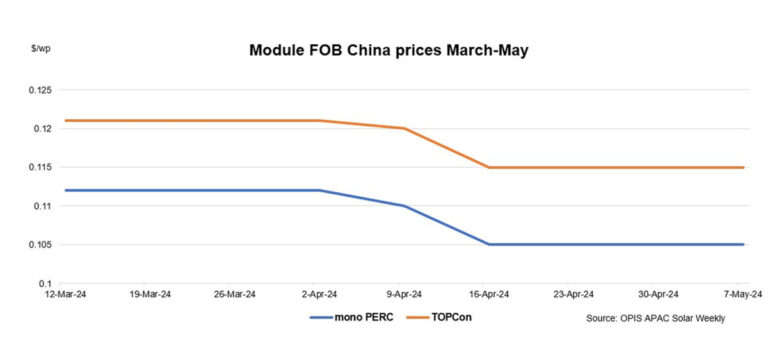In a new weekly update for pv magazineOPIS, a Dow Jones company, provides a brief overview of the major price trends in the global PV industry.
The Chinese Module Marker (CMM), OPIS benchmark rating for TOPCon modules from China, and mono-PERC module prices remained stable at $0.115 per W and $0.105/W, respectively.
Market activity in the Chinese market has yet to pick up, although Chinese solar companies have returned after the Labor holidays. Trading remained subdued with few buyers in the market and these buyers were mainly bargain hunting, a market source said.
Demand remained weak as upstream prices in the solar value chain had previously suffered losses before the Labor holidays. Although upstream prices remained stable this week in a quiet market, market sources expect prices to decline in the coming days as trading activity resumes.
Module prices are expected to continue their downward trend amid weakness in the upstream sector, many agreed during OPIS’ weekly market survey. However, other market participants pointed out that module prices have already fallen below production costs, which are around $0.126/W, and that there is no room for further price drops.
Mono-PERC prices are expected to remain stable as supply will gradually decrease and demand will shift to TOPCon modules. Limited availability of mono-PERC modules could lead to mono-PERC prices trading higher, a market veteran said.
Module manufacturers may reduce their operating rates in May to alleviate falling prices and restore the balance between supply and demand in the market. Earlier in April, module manufacturers’ operating rates were between 70% and 100%.
According to the EIA, the global solar cell and module manufacturing industry is currently operating at a capacity utilization rate of approximately 50%.
Trade activity for Southeast Asian modules has remained muted as uncertainty remains over anti-dumping/countervailing duties (AD/CVD). Buyers are taking a wait-and-see approach to policy development and relatively few new contracts have been signed recently, according to a Southeast Asian module manufacturer.
Another market participant noted that module prices are likely to increase in anticipation of the possible tariffs. Nevertheless, these expected price increases have not yet had an impact on the market, as buyers remain reluctant to win new contracts due to high inventory levels in the United States.
OPIS, a Dow Jones company, provides energy prices, news, data and analysis on gasoline, diesel, jet fuel, LPG/NGL, coal, metals and chemicals, as well as renewable fuels and environmentally friendly feedstocks. It acquired assets with pricing data from Singapore Solar Exchange in 2022 and now publishes the OPIS APAC Solar Weekly Report.
The views and opinions expressed in this article are those of the author and do not necessarily reflect those of the author pv magazine.
This content is copyrighted and may not be reused. If you would like to collaborate with us and reuse some of our content, please contact: editors@pv-magazine.com.


